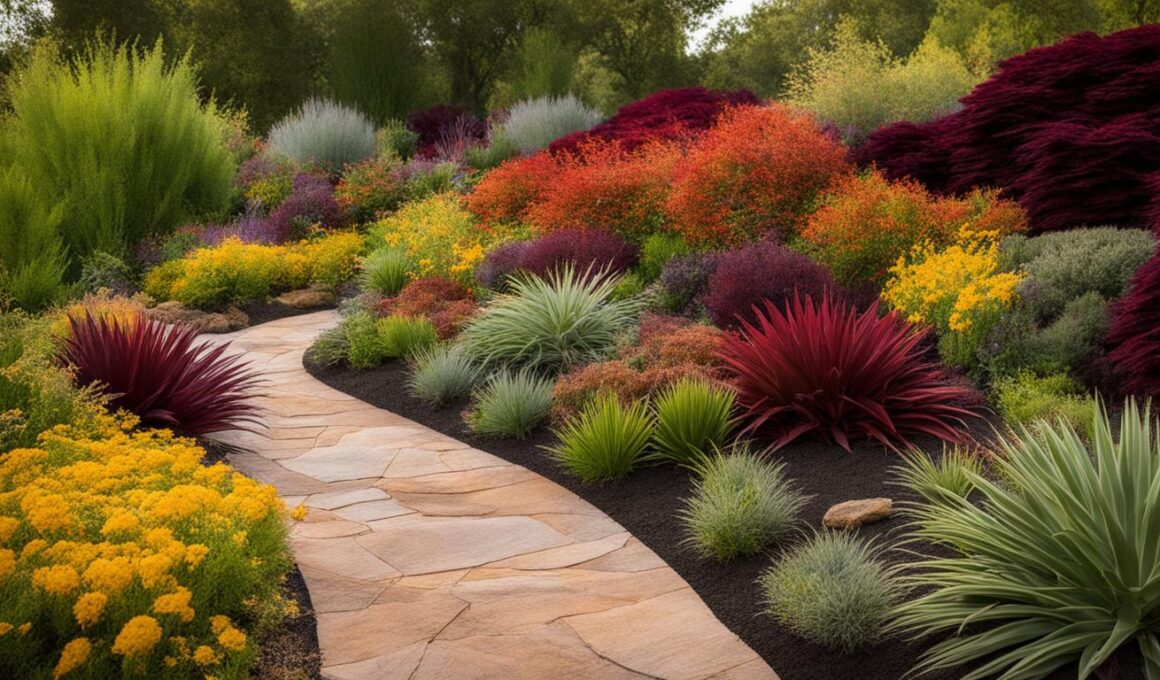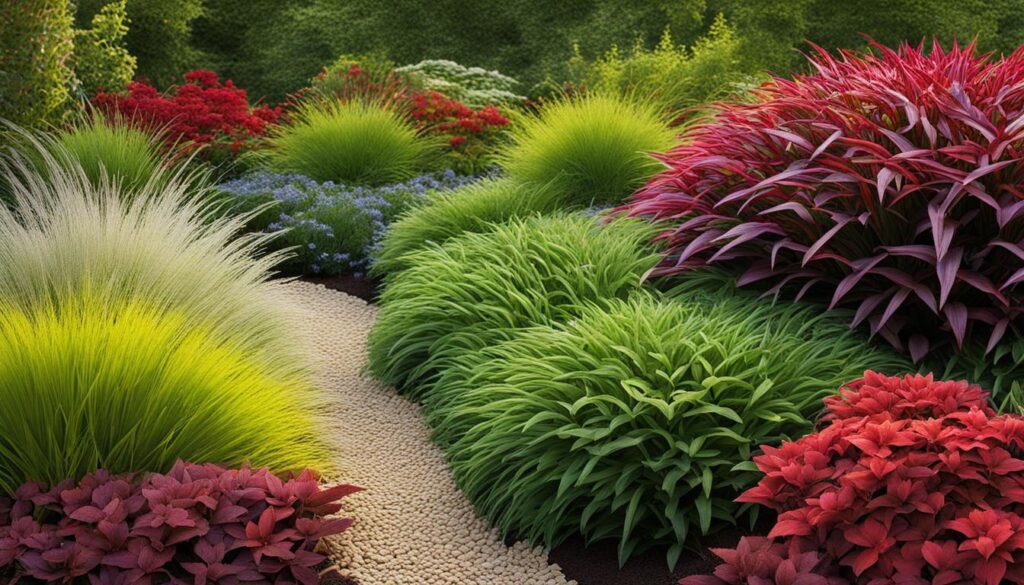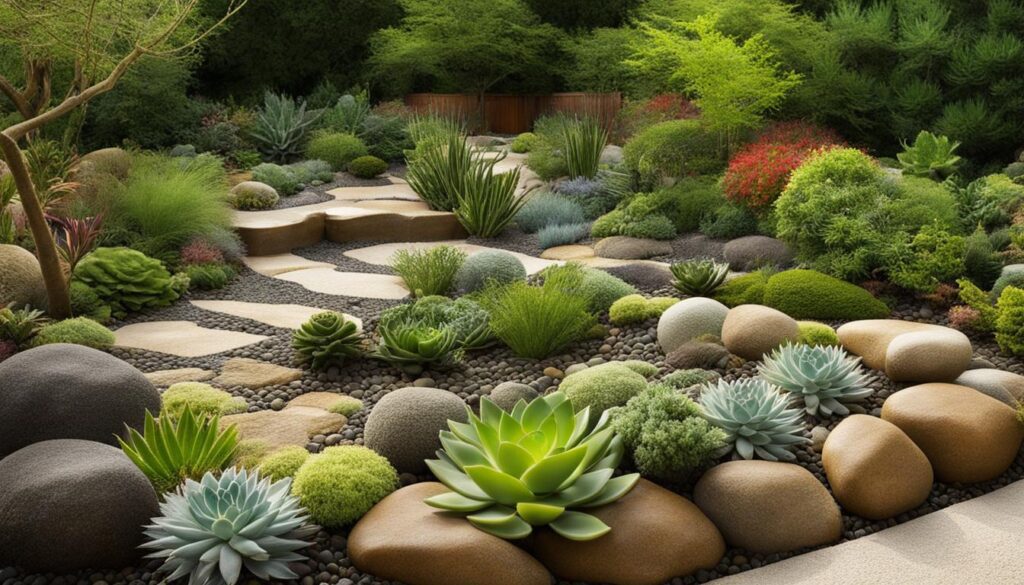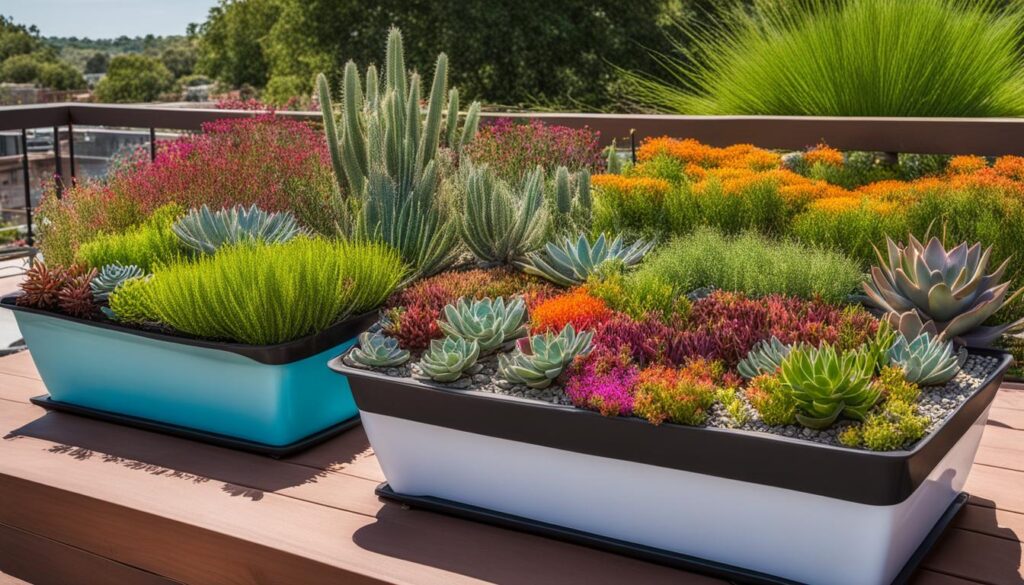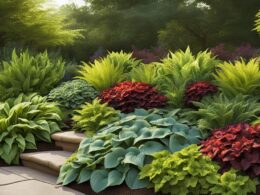Are you looking to create a beautiful and low-maintenance landscape in a dry environment? Look no further than xeriscaping, a popular landscaping technique that can transform your outdoor space. And when it comes to xeriscaping, colorful mulch options play a vital role in enhancing both the aesthetics and functionality of your garden.
By utilizing colorful mulch, you can slow down evaporation, improve fertility, limit weed growth, and add curb appeal to your xeriscape design. With a variety of options to choose from, such as pine bark, crushed stones, gravel, and shredded bark, you have the opportunity to create a unique and vibrant landscape that complements your preferred xeriscape style.
When selecting mulch, it’s important to opt for natural and clean options that are free from dyes, pesticides, or herbicides. This ensures a healthy and environmentally friendly environment for your plants and garden.
Key Takeaways:
- Colorful mulch options are essential for enhancing the aesthetics and functionality of your xeriscape garden.
- Pine bark, crushed stones, gravel, and shredded bark are popular choices for colorful mulch.
- Choose natural and clean mulch options that are free from dyes, pesticides, or herbicides.
- Colorful mulch helps slow down evaporation, improve fertility, and limit weed growth.
- Adding colorful mulch can significantly boost the curb appeal of your xeriscape design.
Select Low-Growing Groundcovers and Ornamental Grasses for Xeriscaping
Xeriscaping, with its focus on conserving water and creating low-maintenance landscapes, encourages the use of low-growing groundcovers and ornamental grasses. These plants not only add visual interest to your xeriscape garden but also require less water and maintenance compared to traditional grass lawns.
When selecting low-growing groundcovers, consider options such as creeping thyme, lantana, silver carpet, zoysiagrass, creeping red fescue, sweet woodruff, low-lying sedum, and creeping phlox. These plants are drought-tolerant and can quickly spread to cover large areas, suppressing weed growth and reducing the need for frequent watering. Mixing different species of low-growing groundcovers in your landscape design can create a diverse and dynamic look.
In addition to groundcovers, incorporating ornamental grasses can add texture and movement to your xeriscape garden. Maiden grass, switchgrass, Mexican feather grass, Russian sage, coneflower, and yarrow are popular choices. These grasses are well-adapted to dry conditions and can withstand periods of drought without sacrificing their aesthetic appeal. Consider planting them in clusters or drifts for a natural, prairie-like effect.
Benefits of Low-Growing Groundcovers and Ornamental Grasses in Xeriscaping:
- Require less water and maintenance compared to traditional grass lawns.
- Suppress weed growth, reducing the need for herbicides.
- Add visual interest, texture, and movement to the landscape.
- Provide habitat for beneficial insects and wildlife.
- Prevent soil erosion and improve soil health.
Tips for Selecting and Maintaining Low-Growing Groundcovers and Ornamental Grasses:
- Choose varieties that are well-suited to your climate and soil conditions.
- Consider the height and spread of the plants when planning their placement in your landscape.
- Ensure proper irrigation during the establishment period to promote healthy root growth.
- Regularly monitor and control weeds that may compete with low-growing groundcovers.
- Trim back ornamental grasses in early spring to remove dead foliage and promote new growth.
| Plant | Type | Height | Spread | Water Needs |
|---|---|---|---|---|
| Creeping Thyme | Groundcover | 2-3 inches | 12-18 inches | Low |
| Lantana | Groundcover | 12-24 inches | 24-48 inches | Low |
| Silver Carpet | Groundcover | 1-2 inches | 12-18 inches | Low |
| Zoysiagrass | Grass | 1-2 inches | 12-18 inches | Low |
| Maiden Grass | Grass | 5-8 feet | 3-6 feet | Low |
| Russian Sage | Grass | 3-4 feet | 2-4 feet | Low |
By incorporating low-growing groundcovers and ornamental grasses into your xeriscape design, you can create an aesthetically pleasing and water-efficient landscape that thrives in dry environments. These plants not only add beauty to your garden but also contribute to water conservation efforts, making them ideal choices for xeriscaping.
Enhance Your Xeriscape Design with Garden Paths and Rock Gardens
Creating garden paths and incorporating rock gardens can take your xeriscape design to the next level. These elements not only serve a functional purpose, but they also add aesthetic appeal and environmental benefits to your landscape. Let’s explore how you can enhance your xeriscape design with garden paths and rock gardens.
Create Functional and Eco-Friendly Garden Paths
Garden paths are an essential component of any landscape design, and they can be especially beneficial in a xeriscape. When choosing materials for your garden paths, opt for options that allow rainwater to reach the soil and be absorbed for later use. Porous pavers or gravel paths are excellent choices as they allow water to permeate through, preventing runoff and promoting water conservation. Not only are these materials eco-friendly, but they also add a charming and rustic touch to your xeriscape design.
Integrate Rock Gardens for Visual Interest and Moisture Retention
Rock gardens are a popular choice in xeriscaping, as they not only add visual interest but also help conserve moisture in the soil. By using boulders, rocks, and a variety of drought-resistant plants such as cacti, succulents, wildflowers, and herbs, you can create a stunning rock garden that requires minimal water and maintenance. The rocks act as a natural barrier, reducing evaporation and trapping moisture in the ground beneath them. Additionally, incorporating natural stones and varying the size of pavers can add texture and dimension to your xeriscape garden.
Plan Your Garden Paths and Rock Gardens for Optimal Placement
When incorporating garden paths and rock gardens into your xeriscape design, it’s important to consider their placement for both functionality and aesthetics. Garden paths should connect different areas of your landscape, providing easy access to various elements such as seating areas, focal points, or garden beds. Similarly, rock gardens should be strategically placed to complement the overall layout of your xeriscape design. By carefully planning and integrating these elements, you can create a cohesive and visually appealing xeriscape garden.
By enhancing your xeriscape design with garden paths and rock gardens, you can create a beautiful, eco-friendly, and low-maintenance landscape. These elements not only add functionality and visual interest but also contribute to water conservation in dry environments. So, get creative with your garden paths and rock gardens, and enjoy the beauty and benefits of xeriscaping.
Embrace Colorful Drought-Hardy Herbs and Succulents in Xeriscape Containers
Containers can be a great addition to xeriscaped landscapes. When it comes to choosing plants for containers, opting for drought-tolerant options is key. Succulents, such as cacti, agave, aloe, sedum, crassula, and gasteria, are perfect choices as they require minimal water and maintenance. They add volume, structure, and vibrant colors to the garden. Additionally, drought-hardy herbs like thyme, rosemary, oregano, and lavender can be planted in containers and used for culinary purposes.
Terracotta pots are recommended for drought-tolerant plants as they provide proper drainage and prevent waterlogging. Their porous nature allows excess water to evaporate, reducing the risk of root rot. When selecting containers, consider the size and growth habit of the plants. Choose containers that are appropriate for the plant’s eventual size and ensure they have drainage holes to prevent water accumulation.
Grouping drought-hardy herbs and succulents in containers can create visually appealing displays. Mix different varieties with contrasting colors, textures, and growth habits to add visual interest. Consider pairing trailing succulents with upright herbs or creating a centerpiece with a tall herb surrounded by smaller succulents. Experiment with different container arrangements to find the perfect combination for your xeriscape garden.
By incorporating colorful drought-hardy herbs and succulents in containers, you can maximize the beauty of your xeriscape landscape while minimizing water usage and maintenance. Containers provide flexibility and allow you to easily move or rearrange plants as desired. Whether placed on a patio, balcony, or scattered throughout the garden, these containers will add a burst of color and texture to your xeriscape design.
Add Annual Drought-Tolerant Plants and Perennials to Your Xeriscape Garden
Enhance the beauty and sustainability of your xeriscape garden by incorporating a variety of annual drought-tolerant plants and perennials. These plants not only add color and interest to your landscape but also thrive in dry conditions, reducing your water consumption and maintenance needs.
Annual Drought-Tolerant Plants
Annuals are plants that complete their life cycle in one growing season. They are a great way to introduce vibrant colors and seasonal variety to your xeriscape garden. Here are some popular annual drought-tolerant options:
- African Daisy: Known for its striking orange and yellow flowers, African Daisy adds a pop of color to any xeriscape garden.
- California Poppy: With its bright orange or yellow blooms, California Poppy is a low-maintenance and drought-tolerant choice.
- French Marigold: This annual flower not only adds vibrant color to your garden but also repels pests with its natural fragrance.
- Creeping Zinnia: Ideal for ground cover, creeping zinnia produces small, vibrant flowers that create a carpet of color.
Perennials for Long-Term Beauty
Perennials are plants that come back year after year, providing long-lasting beauty to your xeriscape garden. Consider incorporating these drought-tolerant perennials:
- Maiden Grass: With its graceful arching leaves and feathery plumes, maiden grass adds texture and movement to your landscape.
- Switchgrass: This native grass offers a variety of colors and textures, providing visual interest throughout the year.
- Mexican Feather Grass: Known for its delicate and wispy appearance, Mexican feather grass creates a beautiful, flowing effect in the garden.
- Russian Sage: With its aromatic foliage and stunning purple flowers, Russian sage adds both beauty and fragrance to your xeriscape.
- Coneflower: This perennial plant produces vibrant and daisy-like flowers in various shades of pink, purple, and white.
- Yarrow: With its feathery foliage and clusters of small flowers, yarrow is a versatile and attractive addition to any xeriscape garden.
When selecting and arranging plants in your xeriscape garden, remember to group them according to their water needs. This allows for efficient water usage and ensures that each plant receives the appropriate amount of moisture. By incorporating annual drought-tolerant plants and perennials into your xeriscape garden, you can create a beautiful and sustainable landscape that thrives in dry conditions.
What are the Benefits of Using Custom Mulching Blends for Xeriscaping?
Using custom mulching blends xeriscapes for xeriscaping has several benefits. These blends help conserve water, suppress weed growth, and improve soil health. They also enhance the overall aesthetic appeal of the landscape and provide insulation for plant roots. Custom blends can be tailored to specific soil and plant needs, making them a versatile choice for xeriscaping projects.
Conclusion
In conclusion, xeriscaping is a sustainable and water-wise landscaping technique that allows you to create beautiful and low-maintenance gardens in dry environments. By incorporating colorful mulch options, selecting low-growing groundcovers and ornamental grasses, adding garden paths and rock gardens, embracing drought-hardy herbs and succulents in containers, and incorporating annual drought-tolerant plants and perennials, you can enhance both the aesthetics and functionality of your xeriscape garden.
With proper planning and design, xeriscaping can provide long-lasting beauty while conserving water in an environmentally friendly way. By using natural, clean mulch options that are free from dyes and chemicals, you can promote soil fertility and limit weed growth while adding curb appeal to your landscape. Choosing low-growing groundcovers and drought-tolerant grasses reduces the need for excessive watering and mowing, making your xeriscape garden more efficient and sustainable.
Additionally, incorporating garden paths and rock gardens can not only add functionality but also help with rainwater absorption and moisture retention in the soil. The use of drought-hardy herbs and succulents in containers not only adds vibrant colors but also requires minimal water and maintenance. Lastly, the inclusion of annual drought-tolerant plants and perennials provides versatility and seasonal interest to your xeriscape garden.
So, whether you live in a dry climate or are looking for a low-maintenance landscaping option, consider xeriscaping. With its various elements and careful plant selection, you can create a beautiful, water-wise garden that will thrive even in challenging conditions.





